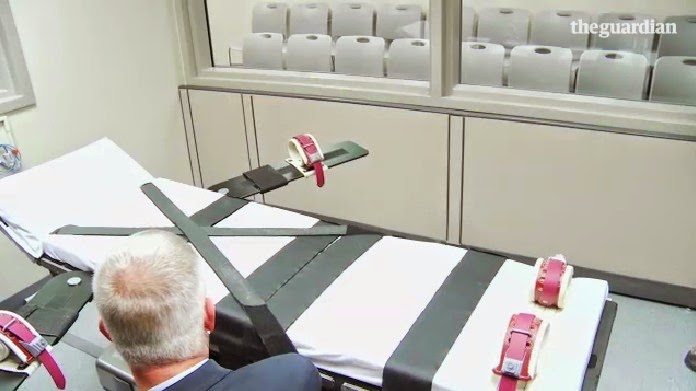 |
| Oklahoma's brand new death chamber |
With a renovated death chamber, new training and a higher dose of drugs, corrections officials in Oklahoma were ready Thursday to carry out the first execution there since April, when the
slipshod, prolonged killing of Clayton D. Lockett forced the state to suspend lethal injections and make changes to its procedure.
The
grisly details of Mr. Lockett’s execution led to new questions, in Oklahoma and around the country, about the reliability of lethal injection as a humane procedure and about the new drug combinations being tried as once-preferred drugs became scarce.
But in the end, federal courts
cleared the way for Oklahoma to resume lethal injections, using a sedative that some medical experts say may not consistently put prisoners into the deep coma needed to avoid suffering.
Barring a last-minute reprieve from the Supreme Court, Charles F. Warner is to be put to death at 6 p.m. local time at the Oklahoma State Penitentiary in McAlester. Mr. Warner, 47, was condemned for the murder and sexual assault of an 11-month-old girl in 1997.
Mr. Warner was originally scheduled to die on April 29, 2014, two hours after Mr. Lockett. But his
execution was postponed after the problems with Mr. Lockett’s lethal injection. The prisoner seem to wake and writhed in agony after a doctor failed to place the intravenous line in a vein, causing the sedative, then a paralyzing agent and a caustic heart-stopping drug, to diffuse in his groin. Mr. Lockett finally died 43 minutes into a procedure expected to take no more than 10 to 15 minutes and after a doctor seeking to reinsert a needle punctured an artery, resulting in what the prison warden later called “a bloody mess.”
After an investigation of what went wrong in the Lockett execution, Oklahoma put new equipment in its death chamber to help ensure proper placement of intravenous catheters and said that if the paramedic or doctor was unable to place a needle within one hour, officials might postpone the event. They also decided to multiply the dose of midazolam, to the level used in Florida.
The news media and civil liberties groups have complained that Oklahoma’s remodeled execution chamber and new procedures have limited the ability of the public to observe lethal injections there. Officials say there is room for only five witnesses from the news media, compared with 12 before. Audio from the chamber will be turned off, and the state’s corrections director can close the curtains and block the view of the witnesses at his discretion.
Source: The New York Times, Erik Eckholm, January 15, 2015
Report an error, an omission: deathpenaltynews@gmail.com










